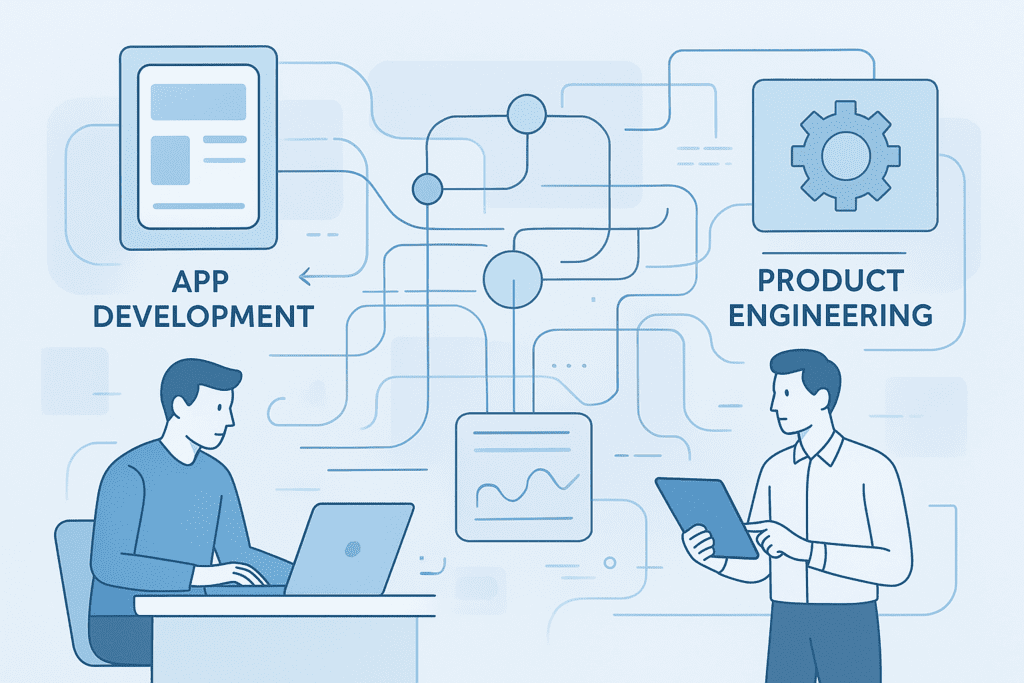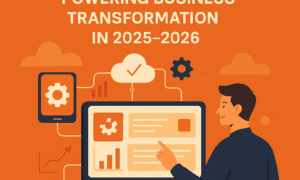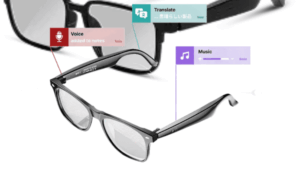Collaboration between app development and product engineering through connected workflows and data lines.
Why Alignment Between Products and App Development Defines Success
In today’s rapidly evolving digital landscape, developing products and executing successful app development must move hand in hand. When teams work in isolation, communication gaps, design inconsistencies, and delivery delays often slow innovation. Therefore, aligning these two processes from the start creates clarity, reduces rework, and enables faster delivery of every new product to market.
Moreover, strong alignment encourages better understanding of user journeys, data dependencies, and testing priorities, allowing both product and app teams to anticipate issues before they arise. As a result, collaboration becomes more fluid, workflows stay consistent, and innovation flows without disruption across all platforms.
Ultimately, companies that synchronize app development with product planning build resilient, scalable ecosystems capable of adapting to change. This continuous alignment ensures that innovation isn’t forced — it evolves naturally through seamless teamwork and shared objectives.
The Growing Complexity of Developing Products and Apps Together
As technology evolves, developing products and managing effective app development have become far more complex than before. Teams now juggle multiple platforms, frameworks, and user expectations simultaneously. Because every decision affects both systems, even a small misstep can delay releases, raise costs, or compromise performance across a new product’s ecosystem.
Additionally, constant market shifts and changing user behaviors push companies to rethink their development processes. As a result, teams must collaborate across departments, share insights continuously, and maintain synchronized pipelines to prevent duplication and design fragmentation. This cross-functional complexity demands technical precision and strong project management discipline to stay ahead.
Ultimately, as app development scales with product innovation, businesses need to embrace adaptive workflows, data-driven coordination, and smarter integration models. By doing so, they transform complexity into opportunity—enabling faster delivery, improved scalability, and lasting success.
Core Challenges When Developing Products and Apps in Parallel
When a business pursues developing products and app development simultaneously, complexity multiplies. Each process has its own architecture, testing frameworks, and design objectives. Yet, both depend on one another to deliver a seamless experience. Without tight synchronization, teams encounter technical disruptions, resource overlaps, and launch delays.
Moreover, limited cross-team communication leads to fragmented results. To overcome this, companies must structure collaboration, encourage transparent reporting, and use integrated workflows that connect product and app pipelines. Still, the following recurring challenges remain at the heart of this process.
Key challenges in aligning app and product development — from integration and performance to security, scalability, and maintenance.
Technical and Integration Barriers
Technical complexity often grows faster than teams can manage. As both app and product systems expand, maintaining stable integrations becomes increasingly difficult. Teams may use incompatible APIs, outdated frameworks, or siloed architectures that make synchronization painful.
To solve these integration hurdles, companies should:
- Adopt modular architecture to isolate and update services easily.
- Create shared code repositories to unify development.
- Establish DevOps pipelines that automate deployment and reduce manual errors.
With structured frameworks and version control in place, integration becomes smoother, more reliable, and less prone to failure.
UX and Design Disconnects in Development
When different teams handle interface design separately, user experience inconsistency becomes a serious issue. Users notice when a product’s mobile app feels different from its web version — and that disconnect erodes trust. Common mistakes include mismatched color palettes, inconsistent typography, and unaligned interactions.
To maintain design harmony, teams should:
- Build shared design systems and reusable component libraries.
- Conduct joint design reviews to ensure visual and functional consistency.
- Test users flow regularly across both platforms.
This consistent design language strengthens usability and creates familiarity across every new product experience.
Performance and Scalability Challenges
Performance degradation is one of the most visible signs of poor coordination. When backend systems aren’t optimized or frontends are overloaded, users face lag, crashes, or incomplete responses. Moreover, scaling infrastructure late in the project often leads to higher costs and slower recovery.
To address performance risks early:
- Integrate load balancing, caching, and stress testing before release.
- Implement microservices for flexible scaling.
- Continuously monitor performance metrics to catch slowdowns proactively.
Proactive optimization ensures both systems deliver speed, stability, and reliability — even as user demand grows rapidly.
Data Synchronization and System Dependencies
A lack of real-time synchronization between product databases and app layers creates data inconsistencies, user frustration, and reporting errors. For example, a user might update data in the app that doesn’t immediately reflect on the backend, breaking workflow accuracy.
To fix this recurring issue:
- Use automated synchronization pipelines for bi-directional updates.
- Define clear API ownership and dependency maps.
- Implement versioned endpoints to prevent mismatch across modules.
Reliable data flow ensures information remains accurate, scalable, and traceable across all connected systems.
Security and Privacy Risks
As integrations increase, so do vulnerabilities. Each connection — whether through APIs, third-party plugins, or cloud services — becomes a potential entry point for breaches. Without continuous monitoring, even small misconfigurations can expose sensitive information.
To strengthen protection across environments:
- Use end-to-end encryption and role-based access control.
- Conduct frequent security audits and penetration tests.
- Automate compliance validation within CI/CD pipelines.
Embedding security into daily processes makes protection scalable, ensuring that privacy safeguards evolve with each release.
Cross-Platform Compatibility Issues
Delivering identical functionality across devices is complex. Operating systems, browsers, and frameworks behave differently, leading to inconsistencies that frustrate users. Teams often underestimate the effort needed to maintain cross-platform parity during rapid development.
To reduce fragmentation and ensure reliability:
- Employ responsive design and adaptive layout frameworks.
- Test continuously across platforms using cloud-based device labs.
- Update codebases to match OS and browser version changes.
A consistent experience across every platform reinforces reliability and strengthens user satisfaction.
Release Coordination and Deployment Conflicts
When product and app teams operate on separate schedules, release conflicts become inevitable. One system may deploy updates that the other isn’t ready for, resulting in broken dependencies or incomplete features.
To align deployments effectively:
- Centralize release calendars and milestone tracking.
- Automate rollouts using shared CI/CD workflows.
- Include rollback and recovery strategies in every deployment plan.
Synchronized releases eliminate confusion, reduce downtime, and create a consistent update rhythm between app and product ecosystems.
Maintenance and Technical Debt
Rushing features often leads to technical debt — outdated code, redundant modules, or incomplete documentation. Over time, these inefficiencies slow future releases and raise long-term costs.
To minimize debt buildup:
- Schedule refactoring sprints after every major launch.
- Maintain clear documentation for all legacy modules.
- Automate testing to catch regressions early.
Sustainable maintenance keeps systems agile, ensuring that app development continues to evolve without compromising performance or innovation.
Operational and Organizational Challenges in Development
Even with robust technology, many teams struggle with people and process alignment. Managing developing products and app development together often reveals gaps in communication, unclear responsibilities, and slow decision-making. These problems escalate as projects scale across multiple time zones and departments.
Additionally, when leadership fails to synchronize goals, teams may duplicate efforts or prioritize conflicting deliverables. To prevent inefficiency, companies must promote clear reporting, transparent progress tracking, and cross-functional accountability.
Yet, even in mature organizations, several key operational challenges remain consistent — each requiring deliberate structure and continuous attention.
Siloed Communication and Misaligned Goals
When departments operate independently, crucial details fall through the cracks. Product, design, and engineering teams may have different understandings of timelines or priorities, leading to confusion, rework, and scope creep.
To close these gaps effectively:
- Encourage shared sprint planning and cross-department reviews.
- Use collaboration platforms to centralize updates.
- Establish clear ownership of deliverables and decisions.
When communication becomes transparent, productivity rises and product engineering practices align naturally with overall app objectives.
Skill Gaps and Resource Constraints
Many organizations underestimate how resource shortages affect speed and innovation. When teams lack specialized skills—like backend optimization or UI engineering—projects slow down and quality suffers.
To overcome these barriers:
- Evaluate skills early in project planning.
- Use staff augmentation to fill expertise gaps quickly.
- Provide continuous training for evolving technologies.
Balancing human capacity ensures teams stay agile while maintaining high technical standards during both app and product cycles.
Project Management and Coordination Inefficiencies
Disorganized workflows remain a major source of delay. Without clear visibility into progress, dependencies pile up, and accountability weakens. Delayed decisions or unclear priorities can derail even experienced teams.
To strengthen coordination:
- Adopt agile methodologies for iterative delivery.
- Maintain shared dashboards that track project metrics.
- Hold regular alignment meetings to adjust priorities.
With disciplined coordination, both app development and developing products remain synchronized, predictable, and on track for timely delivery.
Compliance and Quality Assurance Oversights
When project deadlines tighten, compliance checks and quality assurance cycles often get skipped. However, skipping these steps can expose systems to security flaws or performance regressions after launch.
To maintain reliability without slowing development:
- Embed automated QA pipelines into CI/CD systems.
- Integrate security reviews into every sprint cycle.
- Track compliance documentation in shared repositories.
This proactive quality mindset ensures every new product rollout meets standards for safety, usability, and long-term stability.
Smarter Solutions for Modern App Development
Today’s competitive market demands agility, innovation, and precise execution in every stage of developing products. However, traditional workflows often limit adaptability and slow down delivery cycles. By integrating intelligent automation, AI-driven testing, and collaborative frameworks, teams can drastically improve efficiency and accuracy.
Furthermore, adopting flexible methodologies allows businesses to refine their approach continuously. With the right balance of data, feedback, and cross-platform visibility, companies not only reduce risk but also accelerate innovation. Implementing these smarter strategies ensures that both product and app teams evolve together—delivering sustainable growth for every new product.
AI-Driven Testing and Predictive Maintenance
AI is reshaping the way development teams approach quality control. Instead of reacting to failures, predictive algorithms can anticipate potential issues before they occur. This not only reduces downtime but also cuts testing costs significantly.
To implement AI-enhanced reliability:
- Use machine learning models to detect repetitive bugs.
- Employ predictive analytics to forecast system bottlenecks.
- Automate test coverage for faster, more accurate results.
By enabling AI to guide maintenance and quality assurance, organizations transform testing into a continuous, data-informed process that strengthens every release.
Agile Iteration and Continuous Delivery
Rigid project structures no longer fit the fast-moving world of app development. Agile frameworks, on the other hand, allow teams to pivot quickly based on feedback and performance metrics. However, true agility demands cultural alignment, not just process changes.
To strengthen agile execution:
- Establish short, iterative sprints with measurable outcomes.
- Maintain cross-functional teams to minimize handoffs.
- Embed continuous integration for faster delivery cycles.
This iterative approach promotes transparency, improves adaptability, and ensures that product and app releases evolve in sync with user needs.
Data-Driven Decision Making
Data connects strategy to execution. When both product and app teams leverage real-time insights, they identify problems sooner and optimize performance faster. However, fragmented data systems often limit visibility.
To create a data-powered culture:
- Implement centralized analytics dashboards accessible to all teams.
- Use behavioral data to guide feature prioritization.
- Align KPIs between app performance and business outcomes.
By grounding decisions in measurable evidence, companies can enhance predictability, minimize assumptions, and continuously refine both app and product performance.
Metrics that Matter: Measuring Unified Development Success
In a rapidly evolving digital environment, measuring performance is just as critical as building functionality. Successful app development relies on accurate data visibility across all systems and teams. However, many organizations still depend on outdated metrics that fail to reflect real progress. A unified measurement framework allows teams to track both technical stability and customer satisfaction, ensuring that developing products and their apps grow together cohesively.
Moreover, metrics should change over time as each new product matures. The indicators that matter during launch—like release frequency or bug rates—may differ later when scalability and user engagement take priority. By defining shared benchmarks and performance standards, businesses can transform raw data into strategic insights that shape long-term growth and innovation.
Performance and Quality Indicators
System performance defines how efficiently technology supports the user experience. When development teams neglect continuous monitoring, minor issues often escalate into larger performance gaps. To avoid this, it’s essential to maintain a consistent measurement rhythm that blends technical data with business impact.
Key metrics such as response time, latency, and system uptime highlight whether users experience friction or fluidity. As both app development and developing products advance, performance data becomes a shared language between technical and strategic teams—guiding optimization and ensuring that every release meets enterprise-grade reliability standards.
User Engagement and Retention Metrics
Engagement and retention represent the true pulse of a product’s success. Beyond downloads or signups, these metrics reveal how deeply users connect with a product or app over time. When engagement declines, it often signals usability problems, weak onboarding, or unaligned feature development.
Therefore, tracking engagement patterns enables teams to refine their decisions with clarity. Continuous monitoring of user activity, session duration, and feature adoption uncovers what truly resonates. Ultimately, this feedback-driven approach ensures that developing products evolve in step with user expectations—creating experiences that keep audiences active, loyal, and satisfied.
Future Trends Transforming Product–App Integration
The future of app development and developing products is being reshaped by rapid innovation. As digital systems evolve, five major trends are redefining how organizations design, build, and scale every new product. Together, they’re transforming workflows into intelligent, sustainable, and connected ecosystems.
- AI-Augmented Collaboration is turning automation into teamwork. Intelligent systems now assist in testing, task prediction, and documentation, helping teams make faster, smarter decisions while maintaining consistent quality.
- Low-Code and No-Code Development empowers non-engineers to participate in digital creation. These platforms accelerate prototyping, minimize manual coding, and shorten delivery timelines across complex ecosystems.
- Sustainability and Resource Efficiency are no longer optional. Businesses are now focusing on energy-optimized code, reduced cloud waste, and green architecture, creating systems that balance performance and responsibility.
- Edge Computing and Real-Time Responsiveness improve data speed and reliability by processing information closer to users. This ensures seamless performance for applications and connected devices.
- Cross-Team Automation Ecosystems link analytics, testing, and deployment workflows. Through automation, previously isolated teams now collaborate continuously, improving visibility and release accuracy across all projects.
Collaboration in the Cloud: Remote Development at Scale
As teams become increasingly distributed, cloud collaboration has become the foundation of modern app development and developing products. Global workforces depend on unified cloud environments to maintain speed, consistency, and quality—no matter where contributors are located. When managed effectively, these systems eliminate communication barriers, streamline version control, and support seamless integration.
Moreover, the cloud transforms coordination into a continuous process rather than a challenge. It centralizes data access, testing environments, and monitoring tools, allowing product and app teams to work in perfect sync. This connectivity ensures that even when teams operate remotely, every new product moves from concept to launch with precision, transparency, and shared accountability.
Unified Cloud Toolchains and Integration Pipelines
Integrated cloud toolchains combine all the moving parts of development—from source control to automated deployment—within a single environment. This unification reduces redundancy, improves traceability, and keeps updates consistent across multiple projects.
Cloud-based pipelines also make testing and deployment more predictable, enabling faster delivery cycles with fewer human errors. As collaboration expands globally, unified infrastructure becomes the key to maintaining stability and speed while supporting innovation in developing products and apps.
Managing Productivity Across Time Zones
Remote collaboration introduces unique coordination challenges. Teams spread across regions often face delays due to asynchronous communication or unclear handoffs. However, when processes are well-structured, time zones can become an advantage rather than an obstacle.
Using asynchronous workflows, automated reporting, and centralized dashboards, teams can continue progress around the clock. Clear documentation and transparent updates allow others to pick up instantly where work left off. In this way, cloud-based collaboration transforms distributed development into a 24/7 innovation engine.
Conclusion — Turning Challenges into Long-Term Opportunities
The most successful organizations treat app development and developing products not as parallel goals, but as parts of a single evolving process. By synchronizing design, engineering, and execution early, they build a foundation of clarity, collaboration, and adaptability that sustains long-term innovation.
While challenges such as integration, performance, and team alignment remain constant, their impact can be minimized through smarter planning and shared accountability. As digital ecosystems expand, every new product becomes an opportunity to strengthen processes and refine collective intelligence.
Ultimately, success belongs to teams that transform coordination into strategy and complexity into innovation. With every aligned launch, businesses not only create better technology—they also shape a more connected, resilient, and forward-thinking future.
Frequently Asked Questions (FAQs)
- What are the biggest challenges when developing products and apps together?
The most common challenges include technical integration, UX inconsistency, and performance issues. Managing teams across different frameworks, testing processes, and deployment cycles also increases complexity. Aligning both app and product pipelines helps maintain stability and reduce rework. - How can businesses streamline app development during new product creation?
Companies can streamline workflows by using modular architecture, shared codebases, and continuous integration pipelines. These practices enhance transparency, reduce duplication, and help both teams iterate faster during new product development. - Why does cross-team communication matter in app development?
Effective communication ensures that design, engineering, and testing teams stay aligned on goals and dependencies. Without it, product and app versions drift apart, causing inconsistent releases and added costs. Regular syncs and clear documentation minimize these risks. - How do scalability and performance affect long-term product success?
Scalability ensures that as users grow, systems continue to perform reliably. Poor planning often leads to slow apps or unstable platforms. Integrating performance monitoring, load testing, and scalable infrastructure early ensures smooth growth for every new product. - What’s the best approach to maintaining security in connected app and product systems?
Since integrated ecosystems share sensitive data, security must be proactive. Businesses should embed encryption, multi-factor authentication, and compliance validation into their app development pipelines. Regular audits and version control help safeguard both users and systems.



































